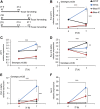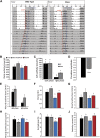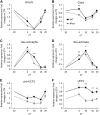β-Adrenergic receptors control brown adipose UCP-1 tone and cold response without affecting its circadian rhythmicity
- PMID: 29715048
- PMCID: PMC6133705
- DOI: 10.1096/fj.201800452R
β-Adrenergic receptors control brown adipose UCP-1 tone and cold response without affecting its circadian rhythmicity
Abstract
Brown adipose tissue (BAT) thermogenic functions are primarily mediated by uncoupling protein (UCP)-1. Ucp1 gene expression is highly induced by cold temperature, via sympathetic nervous system and β-adrenergic receptors (βARs). Ucp1 is also repressed by the clock gene Rev-erbα, contributing to its circadian rhythmicity. In this study, we investigated mice lacking βARs (β-less mice) to test the relationship between βAR signaling and the BAT molecular clock. We found that in addition to controlling the induction of Ucp1 and other key BAT genes at near freezing temperatures, βARs are essential for the basal expression of BAT Ucp1 at room temperature. Remarkably, although basal Ucp1 expression is low throughout day and night in β-less mice, the circadian rhythmicity of Ucp1 and clock genes in BAT is maintained. Thus, the requirement of βAR signaling for BAT activity is independent of the circadian rhythmicity of Ucp1 expression and circadian oscillation of the molecular clock genes. On the other hand, we found that βARs are essential for the normal circadian rhythms of locomotor activity. Our results demonstrate that in addition to controlling the BAT response to extreme cold, βAR signaling is necessary to maintain basal Ucp1 tone and to couple BAT circadian rhythmicity to the central clock.-Razzoli, M., Emmett, M. J., Lazar, M. A., Bartolomucci, A. β-Adrenergic receptors control brown adipose UCP-1 tone and cold response without affecting its circadian rhythmicity.
Keywords: Rev-erbα; brown adipocytes; locomotor activity; molecular clock; thermogenesis.
Conflict of interest statement
The authors thank B. B. Lowell (Beth Israel Deaconess Medical Center, Harvard Medical School, Boston, MA, USA) for providing the β-less mice. This work was supported by U.S. National Institutes of Health, National Institute of Digestive Diabetes and Kidney Diseases Grants DK102496 (to A.B.), DK45586 (to M.A.L.), and F30 DK104513 (to M.J.E). The authors declare no conflicts of interest.
Figures



References
-
- Shearman L. P., Sriram S., Weaver D. R., Maywood E. S., Chaves I., Zheng B., Kume K., Lee C. C., van der Horst G. T., Hastings M. H., Reppert S. M. (2000) Interacting molecular loops in the mammalian circadian clock. Science 288, 1013–1019 - PubMed
-
- Bass J., Lazar M. A. (2016) Circadian time signatures of fitness and disease. Science 354, 994–999 - PubMed
-
- Straif K., Baan R., Grosse Y., Secretan B., El Ghissassi F., Bouvard V., Altieri A., Benbrahim-Tallaa L., Cogliano V.; WHO International Agency For Research on Cancer Monograph Working Group (2007) Carcinogenicity of shift-work, painting, and fire-fighting. Lancet Oncol. 8, 1065–1066 - PubMed
-
- Smolensky M. H., Hermida R. C., Reinberg A., Sackett-Lundeen L., Portaluppi F. (2016) Circadian disruption: new clinical perspective of disease pathology and basis for chronotherapeutic intervention. Chronobiol. Int. 33, 1101–1119 - PubMed
Publication types
MeSH terms
Substances
Grants and funding
LinkOut - more resources
Full Text Sources
Other Literature Sources
Molecular Biology Databases

